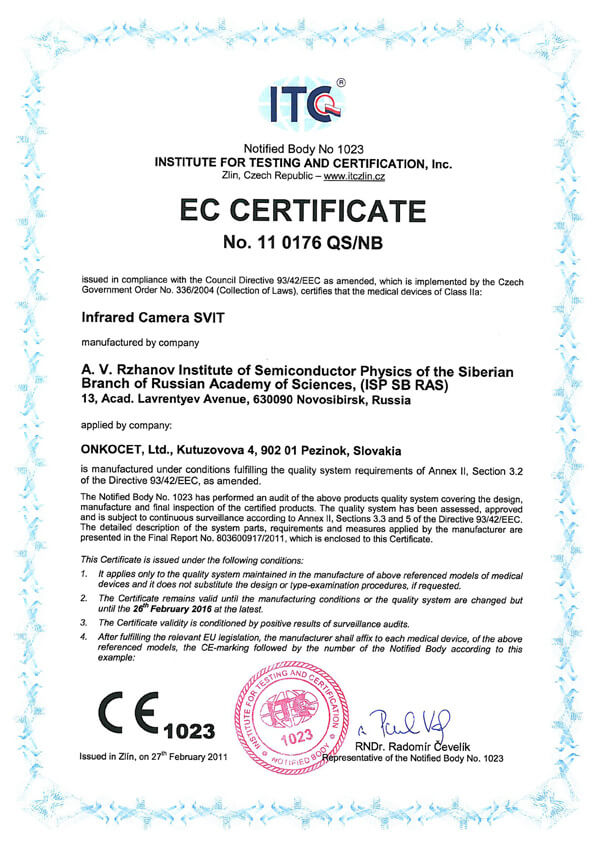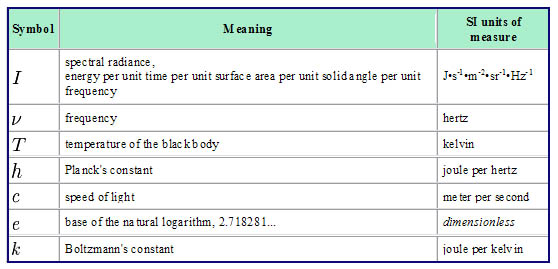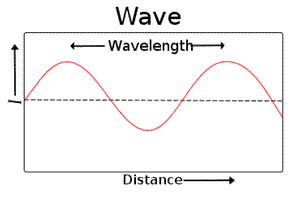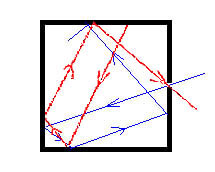Medical devices
search
news

The PDF with the short report with pictures from the therapy of a diabetic foot can be viewed or downloaded here.
The pictures from the treatment of unhealing wounds an be found here:
http://www.onkocet.eu/en/produkty-detail/220/1/
The pictures from the treatment of unhealing wounds an be found here:
http://www.onkocet.eu/en/produkty-detail/293/1/
ONKOCET Ltd. has exhibited the devices from its portfolio on the MEDTEC UK exhibition in Birmingham, April 2011 through our partner Medical & Partners.

 The ONKOCET company has successfully reached the certification of yet another medical device, Infrared Camera SVIT. The Certificate can be found here. The videos from the device operation can be found here.
The ONKOCET company has successfully reached the certification of yet another medical device, Infrared Camera SVIT. The Certificate can be found here. The videos from the device operation can be found here. Our device, the non-invasive blood analyzer AMP has won the Golden Incheba prize at a medical exhibition SLOVMEDICA - NON-HANDICAP 2010. A big thank you goes to the organizers of the exhibition for acknowledging the quality of our device and to the exhibitor, the Medical & Partners company, for introduction of the AMP device to the medical public again.
Our device, the non-invasive blood analyzer AMP has won the Golden Incheba prize at a medical exhibition SLOVMEDICA - NON-HANDICAP 2010. A big thank you goes to the organizers of the exhibition for acknowledging the quality of our device and to the exhibitor, the Medical & Partners company, for introduction of the AMP device to the medical public again.We are pleased to inform our business partners, that our company has succesfully finished the certification process of Concor Soft Contact Lenses.
 You can find the certificate here.
You can find the certificate here.More information on Concor Soft Contact Lenses go to section Medical preparations/Concor soft contact lenses, or follow this link.
 Our company has finished the certification process for another medical device, computerized spirometer MAS-1K with oximeter. You can find the device certificate here.
Our company has finished the certification process for another medical device, computerized spirometer MAS-1K with oximeter. You can find the device certificate here..jpg) Since May 2010 there is a new version of AMP device available.
Since May 2010 there is a new version of AMP device available.Follow this link if you want to see the pictures and specifications of the device.
http://www.onkocet.eu/en/produkty-detail/293/1/
 Dear partners,
Dear partners, In October 2009 we have received CE certificate for another device from our portfolio, NO therapeutical device PLASON. You can find more information about this revolutionary device, used for healing of unhealing wounds, diabetic foot, or for cosmetical purposes, at our webpage, section "Medical devices" -> PLASON-NO Therapy.
.gif)
Best regards
Team of ONKOCET Ltd. company
Black body radiation
PRINCIPLE OF MICROWAVE METHOD OF CANCER DIAGNOSE
BLACK BODY RADIATIONBefore we start to explain what is the main principle of microwave radiometry, we will discuss about the term "black body radiation". So, let's first explain what's a "black body". A "black body" is a theoretical perfect absorber (hypothetic body), which absolutely absorbs radiation of all wavelengths falling on its surface. It reflects no light at normal temperatures and thus appears black.
However, it is a theoretical model. Actual black bodies don't exist in nature - though its characteristics are approximated by a small hole in a box filled with highly absorptive material. The emission spectrum of such a black body was first fully described by Max Planck.
In 1900, Max Planck was working on the problem of how the radiation an object emits is related to its temperature. The intensities of the various wavelengths of radiation emitted by a black body depend only on its temperature.
Planck's law of black body radiation
In physics, Planck's law of black body radiation predicts the spectral intensity of electromagnetic radiation at all wavelengths from a black body at temperature T. Electromagnetic radiation can be imagined as a self-propagating transverse oscillating wave of electric and magnetic fields. ... As the temperature decreases, the peak of the black body radiation curve moves to lower intensities and longer wavelengths. ...

![]()
![]()
![]()
![]()

The wavelength is related to the frequency by Radiance and spectral radiance are radiometric measures that describe the amount of light that passes through or is emitted from a particular area.
.jpg)
Theoretical black body curve for 5000K

Black body radiation curves showing peak wavelengths at various temperatures
Wavelength is the distance between repeating units of a propagating wave of a given frequency. It is commonly designated by the Greekletter lambda (?). Examples of wave-like phenonomena are light, water waves, and sound waves.
Wavelength ? is inverse proportional with the frequency ? (Greek "nu"), the number of wave periods per time unit passing a given point, as in
![]()
.jpg)

Frequency of waves
Frequency has an inverse relationship to the concept of wavelength, simply, frequency is inversely proportional to wavelength ? (lambda). The frequency f is equal to the speed v of the wave divided by the wavelength ? of the wave:
![]()
![]()
.jpg)
In the special case of electromagnetic waves moving through a vacuum, then v = c0 , where c0 is the speed of light in a vacuum, and this expression becomes:
![]()
When waves from a monochromatic source travel from one medium to another, their frequency remains exactly the same — only their wavelength and speed change.
![]()
![]()

Sinusoidal waves of various frequencies; the bottom waves have higher frequencies than those above. The horizontal axis represents time.
A black body is an ideal emitter which is capable of absorbing and emitting all frequencies of radiation uniformly. All black bodies heated to a given temperature emit thermal radiation. The radiation energy per unit time from a blackbody is proportional to the fourth power of the absolute temperature and can be expressed with Stefan-Boltzmann Law as:

For objects other than ideal blackbodies (the grey body concept) the Stefan-Boltzmann Law can be expressed as


For the gray body the incident radiation (also called irradiation) is partly reflected, absorbed or transmitted. The emissivity coefficient lies in the range 0 < ? < 1 depending on the type of material (conductivity) and the temperature of the surface.
The Net Radiation Loss Rate
If an hot object is radiating energy to its cooler surroundings the net radiation heat loss rate can be expressed as:



